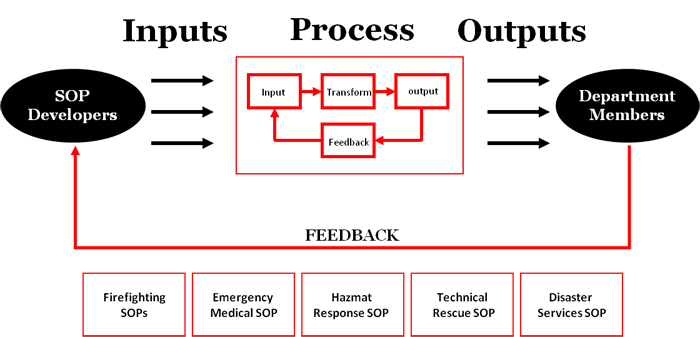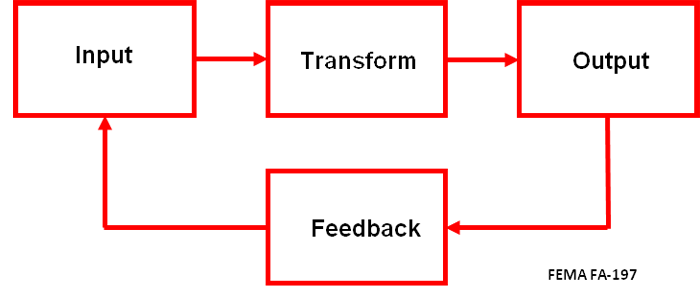SOP Center Incorporates the FA-197 Model
For Fire and Emergency Medical Service, SOPs and SOGs are the primary connection between your department's organizational leadership, policy makers, planners, administration personnel, and your department members and emergency service personnel.
Well-developed SOPs and SOGs employ a logical framework by establishing a departmental processes, that includes formal functions and topics enabling your department or agency to drive member consistency, assist in the delivery of organizational and operational excellence, standardize behavior, avoid confusion, limit liability, improve efficiency, improve training, deliver public education and enhance member and public safety.
In FA-197, FEMA recommends the use of :
"Systems theory, a concept that focuses on the interrelationships among components of a process. In this approach, an organizational system is considered to have four basic elements:
-
inputs from the environment, including information and other resources;
-
transformations, the managerial or technological processes used to convert inputs to outputs;
-
outputs in the form of desired products or services; and
-
feedback, the environment's reaction to outputs, completing the cycle and continually improving results."
These steps are graphically depicted below.

The operation of fire departments and the provisioning of emergency medical services have become a progressively more challenging and difficult tasks. Today, many Fire and EMS organizations have not established the management processes for developing, drafting and implementing departmental policies and guidelines. Most suffer from incomplete, out of date, badly written, poorly understood, or inadequately enforced Standard Operating Procedures and Guidelines.
The basic reasons behind this problem can be many—turnover in personnel occurring because of illnesses, retirement, terminations, the increasing complexity of today's fire service, rapidly changing technology, new regulations and requirements, the narrowing of sovereign immunity coupled with the rising number of lawsuits, shrinking budgets and in some cases leadership may not fully understand the benefits of SOPs and SOGs, or a belief that the effort is too time consuming or too complex.
The Organizational System
"An organizational system is considered to have four basic elements: inputs from the environment, including information and other resources; transformations, the managerial or technological processes used to convert inputs to outputs; outputs in the form of desired products or services; and feedback, the environment’s reaction to outputs. Feedback serves as an input during future iterations of the process, thus completing the cycle and continually improving results". FEMA FA-197

The organizational system concept is a logical framework and an analytical, presentational and management tool which can help planners and managers ensure that department policies are adequately developed, maintained, and enforced.
1. Inputs
|
Collection of information and other resources with the expectation that it will lead to the implementation of the designated outcomes |
2. Transform
|
SOP development is a process used to convert inputs to outputs establishing formal policies and procedures |
3. Ouptut
|
Products and services end-state achieving the objectives with sustainable and desirable outcomes |
4. Feedback
|
The results from the SOP/SOG or protocol change among department Staff or community. |
As stated in FEMA FA-197, the eight steps below are critical in developing SOPs/SOGs that are effective and relevant:
Step One: Develop organizational support for conducting the needs assessment. Support can take many forms, from providing appropriate resources (personnel, time, meeting space, etc.) to demonstrating the commitment of fire and EMS managers to make changes based on the results of the study. The purpose of the needs assessment should be clearly stated and understood by all members of the department.
Step Two: Develop a plan of action. Assign responsibilities, divide tasks, and create a realistic schedule. Conducting a thorough needs assessment can be an intense and time-consuming process. Creating a plan of action helps maintain interest, promote accountability, and helps the group stay focused.
Step Three: Review current SOPs. Develop familiarity with existing SOPs. Look for previously identified problem areas and inconsistencies among SOPs. Consider potential impacts of the department’s operating environment on existing SOPs.
Step Four: Gather information on internal factors affecting SOPs. Examples include other department documents, post-incident analyses, exercises, drills, surveys, and interviews.
Step Five: Consider external factors affecting SOPs. The impact of laws, regulations, and standards should be considered here. Information sources may include literature reviews, professional and trade organizations, Federal and state agencies, other departments, accreditation manuals, and the Internet.
Step Six: Develop a list of required SOPs based on the needs identified in Steps 4 and 5. Consider the impact of internal and external factors, as well as the operating environment and standard of practice.
Step Seven: Analyze existing SOPs based on the information gathered in prior steps. Compare existing SOPs to the list developed in Step 6. Identify areas where new SOPs are needed, or existing ones should be modified or deleted. Realistically prioritize the results in light of department resources. SOPs required by laws or regulations must receive a high priority, as should those addressing critical health and safety issues.
Step Eight: Create a formal needs assessment document. Summarize findings and provide recommendations. Explain priorities and provide a specific rationale for adding, modifying, or deleting SOPs. (e.g., SOP is needed to comply with Federal regulation 29 CFR §1910.120; SOP is needed to address the emerging trend of domestic terrorism, etc.)

Standardization creates predictability, and predictability enables fireground commanders to manage and forecast the needs of the fireground. Well established SOP’s / SOG’s create operational effectiveness for fire departments across the country. The safe and effective management of fire service operations and incidents is dependent upon a structured, predictable, processes, based on firm rules of engagement.
- Identify the objective
- Determine and assemble the essential resources
- Review the current and available material
- Gather and assemble the necessary personnel
- Assign of tasks and mission
- Draft preliminary version
- Review, Revise, and Refine
- Approve and Ratify
- Distribution, Accessibility and Education
- Management, Supervision and Enforcement
- Evaluate, Review and Amend
